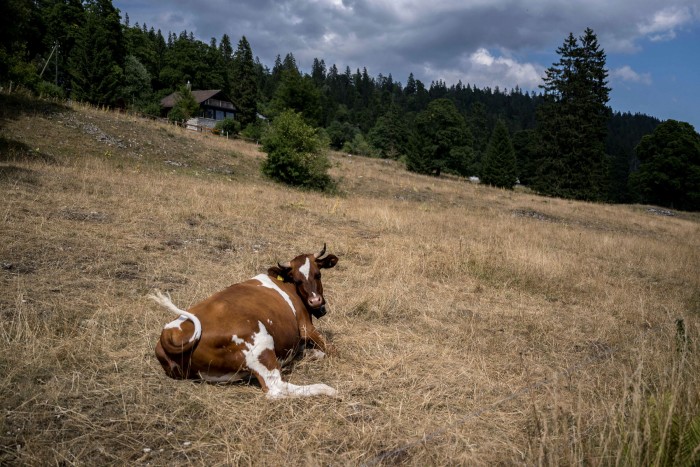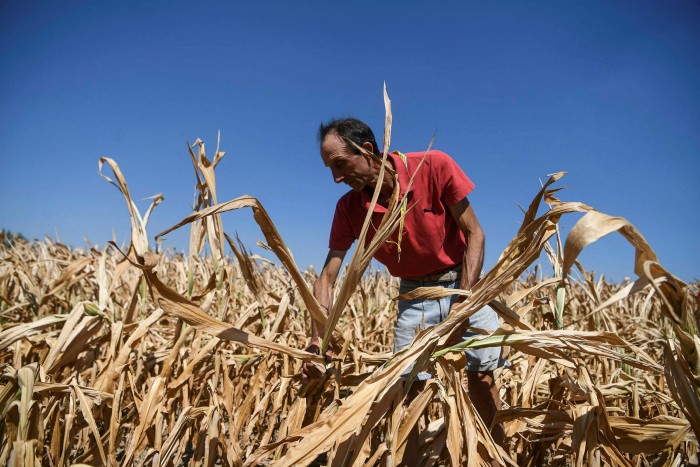In Obwalden, high in the Swiss Alps, the army has been drafted in to save the cows.
With mountain streams in the Alpine country drying up, military helicopters were dispatched last week to transport huge containers of water up to the pastures from the lakes below, in an effort to prevent the herds from dying of thirst.
“In Switzerland we’re not used to the idea of droughts”, said Sonia Seneviratne, professor of land-climate dynamics at ETH Zurich research university. “We see ourselves as being this water fortress of Europe, but as glaciers shrink and summer temperatures become more extreme this is less and less a reality.”
The water shortages are part of a severe drought sweeping the continent from Portugal to eastern Europe and southern England to Italy. Scientists blame the combination of an unusually dry winter followed by an equally dry spring and a summer of baking heat, part of a warming trend brought on by climate change.

The drought and extremely high temperatures across Europe — France has been gripped by a third heatwave of the summer — are affecting households, industry, transport and tourism, as well as farming and agriculture. The tinder-dry ground also provides ideal conditions for the wildfires that have ravaged France, Portugal and other countries.
French prime minister Élisabeth Borne on Friday activated a special crisis unit to tackle what she said was the worst drought in the country’s history. Of the 96 départements in European France, all but three have water restrictions in place and about two-thirds are classified as in “crisis”, according to the environment ministry.
In the western Loire valley, cattle farmer Clément Traineau said it was the worst that he or his 65-year-old father had ever experienced. The grass in his pastures has long since withered due to the heat and months with very little rain, and the corn that would be used to feed his cows later in the year had shrivelled in a hot wind that feels “like a hair dryer”.
“It’s not just the surface, the soil is dry deep down,” he explained. “The trees in the forests are losing their leaves — it’s not pretty. It’s worse than 1976, which used to be the year that everyone referred to.”

Scientists believe summer droughts could become the norm in western Europe — four of the past five summers have been extremely dry — due to the effects of climate change.
“An extreme heat weather event that would have happened once every 10 years without human-induced climate change is now happening three times every 10 years,” Seneviratne explained. “It’s possible that within a decade, every other summer will be like this, and this will get worse if we don’t stop carbon emissions.”
The EU European Drought Observatory’s latest assessment shows a map spattered with red and orange to indicate that 13 per cent of the bloc’s territory was in severe “alert” conditions for the period up to July 10, and 45 per cent in “warning” territory — and the drought has worsened since.
Météo France, the French weather office, said surface soil humidity across the country was the lowest on record. July rainfall, at 9.7mm, was 85 per cent below the seasonal norm and the second-driest month ever recorded, after March 1961. Western France was particularly hot, with temperatures in the town of Biscarrosse reaching 42.6C last month, a local record.
“If there is no significant rain before the end of September, then there’s a risk of things getting very difficult,” said Christian Huyghe, scientific director for agriculture at France’s national institute of agronomic research.

The Netherlands this week declared a national water shortage while authorities in Poland have introduced restrictions on rivers, including the Vistula, the country’s longest, where water levels have dropped close to record lows. In Warsaw, ferry services across the Vistula were suspended for a week last month because of the low level of the water.
If water levels on the Rhine fall by another 7cm then long stretches of one of Europe’s most important industrial highways would become unnavigable for freight traffic. Water levels on Lake Constance, western Europe’s second-largest body of freshwater by volume, have been as low only twice before in recorded history — in 1949 and in 1876.
Some French nuclear power stations have had to reduce output because of environmental rules limiting the temperature of the waste water used for cooling that is returned to rivers. The droughts have also reduced Europe’s hydroelectric power generation, including in the Alps.
Brussels estimated last year that drought-related damage would cost the EU about €9bn per year, soaring to an annual €40bn if global warming was to reach 3C. Temperatures have already increased by at least 1.1C since pre-industrial times, according to scientists.

Some Europeans have turned to the heavens for help. In Cagnano, a hilltop village on the Umbria-Tuscany border of Italy, residents gathered last month to invoke St Vincent Ferrer, patron saint of winegrowers, to bring forth some much-needed rain.
“During these difficult drought days, his intercession before God is crucial,” priest Giorgio Mariotti said in a message to the local community.
In northern France, Denis Bollengier felt the dust on his fingers as he picked potatoes from the dry earth on his farm in the village of Esquelbecq. “Normally when I do this my hands come out muddy,” he said, adding that his annual crop could be halved this year.
“We’re heading towards catastrophe,” he said.
Victor Mallet in Paris, Sam Jones in Zurich, Akila Quinio in Esquelbecq, Raphael Minder in Warsaw, Silvia Sciorilli Borrelli in Milan and Alice Hancock in Brussels
Climate Capital

Where climate change meets business, markets and politics. Explore the FT’s coverage here.
Are you curious about the FT’s environmental sustainability commitments? Find out more about our science-based targets here
For all the latest Business News Click Here
For the latest news and updates, follow us on Google News.
